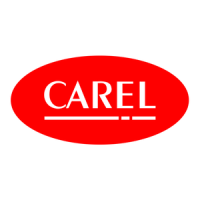Code +030220811- rel. 1.0 – 26.04.2007
22
9. Start-up
When starting control for the first time, make sure that:
1) the electronic valve opens and starts controlling when the start control signal is sent (from digital input, pLAN,
tLAN or built-in controller);
2) the valve position constantly follows the superheat value, opening or closing when the superheat increases or
decreases;
3) the refrigerant flows through the evaporator and the air or water temperature of the controlled utility moves
towards the set point.
If the previous checks fail, check the electrical connections, the water circuit and the parameter settings.
See the following chapter on troubleshooting.
During control, the following also need to be checked:
4) the superheat is always around the set point, with swings that, depending on how perturbed the system is,
vary between 0.2 °C and 4 °C;
5) the valve position always continues to follow the superheat, increasing or decreasing around the working
position;
6) The controlled utility reaches the set point or the required air or water temperature;
7) There is no return of liquid to the compressor.
If the previous checks fail, refer again to the following chapter on troubleshooting.
9.1 Selecting the superheat set point
The superheat set point should be selected based on the recommended value described in chapter 8, and set as
established by the design specifications of the controlled utility.
Nonetheless, it should be stressed that the corresponding parameter can be modified at any time, so as to change
the control reference, exactly in the same way as calibrating a traditional thermostatic valve.
A low
set point ensures better efficiency of the evaporator, a lower air or water temperature and the temperature
control set point is reached more easily. Nonetheless, instability may be created in the system, with wider swings in
the superheat and the return of liquid to the compressor.
A high
set point ensures greater system stability and less or negligible swings in the superheat. Nonetheless, this
may penalise the efficiency of the evaporator and prevent the temperature control set point from being reached.
9.2 Control techniques
The control parameters should only be changed from the recommended values (chapter 8) when it is clear how
these affect the control functions.
Considering, as mentioned, that a lower superheat set point causes swings but often ensures higher efficiency, any
changes to the parameter settings must be made with the objective of the achieving the best compromise between:
• lowering the utility control temperature or reaching the control set point more quickly;
• system stability.
• no return of liquid to the compressor.
In general, to avoid control problems that cause damage to the compressor, the following rules should be observed:
• only change the value of one parameter at a time;
• monitor the superheat trend, the valve position and the utility control temperature for at least 10-30 min
before deciding whether a change has improved or worsened the situation;
• if necessary, extend the period of normal temperature control by temporarily lowering the utility set point,
so as to better check the trend in the superheat;
• check a complete set of parameters in all unit operating conditions (start after extended stop, temperature
control active, defrost, changes in cooling capacity).
control

